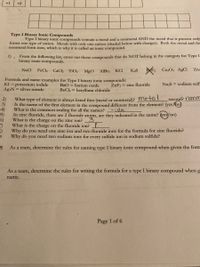
Chemistry
10th Edition
ISBN: 9781305957404
Author: Steven S. Zumdahl, Susan A. Zumdahl, Donald J. DeCoste
Publisher: Cengage Learning
expand_more
expand_more
format_list_bulleted
Question

Transcribed Image Text:+1
+2
Type I Binary Ionic Compounds
Type I binary ionic compounds contain a metal and a nonmetal AND the metal that is present only
forms one type of cation. Metals with only one cation (shaded below with charges). Both the metal and the
nonmetal form ions, which is why it is called an ionic compound.
From the following list, cross out those compounds that do NOT belong in the category for Type I
binary ionic compounds.
1)
KS
NaCl
FeCl2
CaCl2 TiO2
MgO
AIBR3
KCI
Cu2O3 AgCl
Zna
Formula and name examples for Type I binary ionic compounds:
KI = potassium iodide
Ag3N = silver nitride
BaO = barium oxide
ZnF2 = zinc fluoride
Nazs = sodium sulf
BeCl2 = beryllium chloride
Metal
What type of element is always listed first (metal or nonmetal)?
2)
3)
Is the name of the first element in the compound different from the element? (yes/no
4)
What is the common ending for all the names?
5)
In zinc fluoride, there are 2 fluoride atoms, are they indicated in the name? (yesy no)
6)
What is the charge on the zinc ion?
What is the charge on the fluoride ion? I
second? nonm
ide
B)
Why do you need one zinc ion and two fluoride ions for the formula for zinc fluoride?
Why do you need two sodium ions for every sulfide ion in sodium sulfide?
) As a team, determine the rules for naming type I binary ionic compound when given the form
As a team, determine the rules for writing the formula for a type I binary compound when g
name.
Page 1 of 6
Expert Solution
This question has been solved!
Explore an expertly crafted, step-by-step solution for a thorough understanding of key concepts.
This is a popular solution
Trending nowThis is a popular solution!
Step by stepSolved in 2 steps

Knowledge Booster
Similar questions
- Draw a picture of the ions in a crystal (solid) of sodium sulfate. Make sure that the ions are of the appropriate size and are present in the appropriate ratio.arrow_forwardProvide one example of molecule with correct chemical name and one example of ionic compound with correct chemical name.arrow_forwardHello! I'm not sure what to put in the 3 blank spots.arrow_forward
- Predicting the compound formed by two main group elements For each row in the table below, decide whether the pair of elements will form a molecular or ionic compound. If they will, then enter the chemical formula of the compound. If the elements will form more than one compound, enter the compound with the fewest total number of atoms. You may assume all chemical bonds are single bonds, not double or triple bonds. element #1 element #2 compound formed? chemical formula O lonic potassium lithium molecular O neither lonic neon argon O molecular neither ionic potassium fluorine molecular neither Explanation Check 2021 McGraw-Hill Education. All Rights Reserved. Terms of Use I Privacy I Accessi MacBook Pro %2$ 4 1 2 3 5 6 7 8 Q W E T Y F J C V B alt alt optlon command MOSISO command option Varrow_forwardhow do you know if a compound is ionic or covalent?arrow_forwardREFER TO IMAGEarrow_forward
- Which correctly describes a polar covalent bond? Group of answer choices electrons are lost electrons are shared equally between atoms electrons are shared unequally between atoms electrons are gainedarrow_forwardWhats is the formula of the ionic compound formed when calcium and nitrogen ions combine?arrow_forwardAre the following Ionic Compounds, Covalent Compounds or Acids? Write formulas as appropriate for each of the following.arrow_forward
- Which of the following statements is true for an ionic bond? in the picture.arrow_forwardSelect ALL of the properties that are typically found in compounds that have ionic bonding. OExist in lattices OLow melting points Formed between a metal and a nonmetal OHigh melting points OExist as discrete molecules Exhibit bonding which is the electrostatic attraction between cations and anions Share electrons Formed between two nonmetalsarrow_forwardPlease answer all questions.arrow_forward
arrow_back_ios
SEE MORE QUESTIONS
arrow_forward_ios
Recommended textbooks for you
 ChemistryChemistryISBN:9781305957404Author:Steven S. Zumdahl, Susan A. Zumdahl, Donald J. DeCostePublisher:Cengage Learning
ChemistryChemistryISBN:9781305957404Author:Steven S. Zumdahl, Susan A. Zumdahl, Donald J. DeCostePublisher:Cengage Learning ChemistryChemistryISBN:9781259911156Author:Raymond Chang Dr., Jason Overby ProfessorPublisher:McGraw-Hill Education
ChemistryChemistryISBN:9781259911156Author:Raymond Chang Dr., Jason Overby ProfessorPublisher:McGraw-Hill Education Principles of Instrumental AnalysisChemistryISBN:9781305577213Author:Douglas A. Skoog, F. James Holler, Stanley R. CrouchPublisher:Cengage Learning
Principles of Instrumental AnalysisChemistryISBN:9781305577213Author:Douglas A. Skoog, F. James Holler, Stanley R. CrouchPublisher:Cengage Learning Organic ChemistryChemistryISBN:9780078021558Author:Janice Gorzynski Smith Dr.Publisher:McGraw-Hill Education
Organic ChemistryChemistryISBN:9780078021558Author:Janice Gorzynski Smith Dr.Publisher:McGraw-Hill Education Chemistry: Principles and ReactionsChemistryISBN:9781305079373Author:William L. Masterton, Cecile N. HurleyPublisher:Cengage Learning
Chemistry: Principles and ReactionsChemistryISBN:9781305079373Author:William L. Masterton, Cecile N. HurleyPublisher:Cengage Learning Elementary Principles of Chemical Processes, Bind...ChemistryISBN:9781118431221Author:Richard M. Felder, Ronald W. Rousseau, Lisa G. BullardPublisher:WILEY
Elementary Principles of Chemical Processes, Bind...ChemistryISBN:9781118431221Author:Richard M. Felder, Ronald W. Rousseau, Lisa G. BullardPublisher:WILEY

Chemistry
Chemistry
ISBN:9781305957404
Author:Steven S. Zumdahl, Susan A. Zumdahl, Donald J. DeCoste
Publisher:Cengage Learning

Chemistry
Chemistry
ISBN:9781259911156
Author:Raymond Chang Dr., Jason Overby Professor
Publisher:McGraw-Hill Education

Principles of Instrumental Analysis
Chemistry
ISBN:9781305577213
Author:Douglas A. Skoog, F. James Holler, Stanley R. Crouch
Publisher:Cengage Learning

Organic Chemistry
Chemistry
ISBN:9780078021558
Author:Janice Gorzynski Smith Dr.
Publisher:McGraw-Hill Education

Chemistry: Principles and Reactions
Chemistry
ISBN:9781305079373
Author:William L. Masterton, Cecile N. Hurley
Publisher:Cengage Learning

Elementary Principles of Chemical Processes, Bind...
Chemistry
ISBN:9781118431221
Author:Richard M. Felder, Ronald W. Rousseau, Lisa G. Bullard
Publisher:WILEY